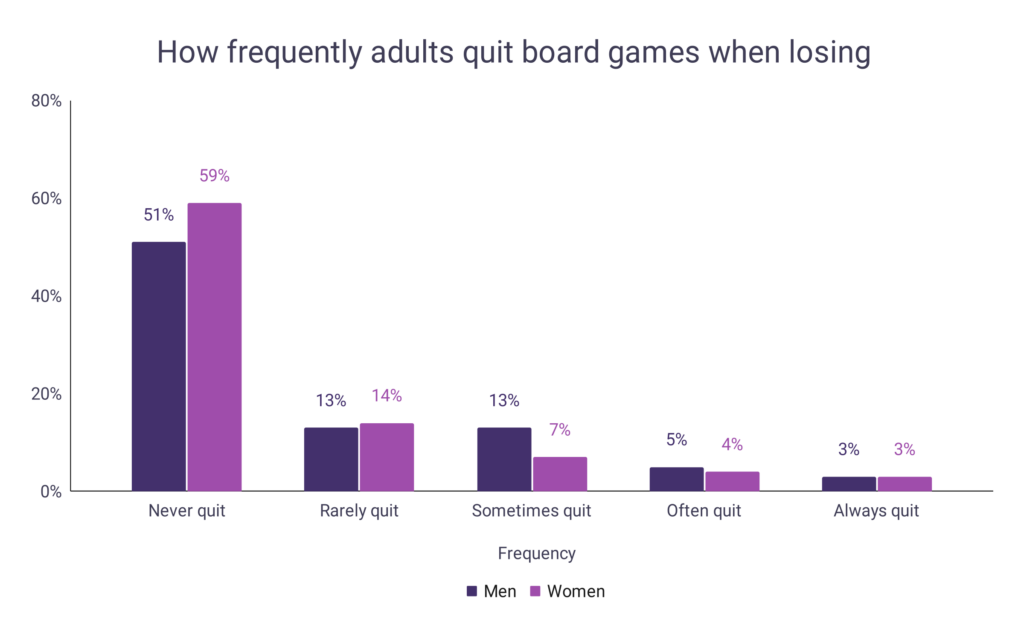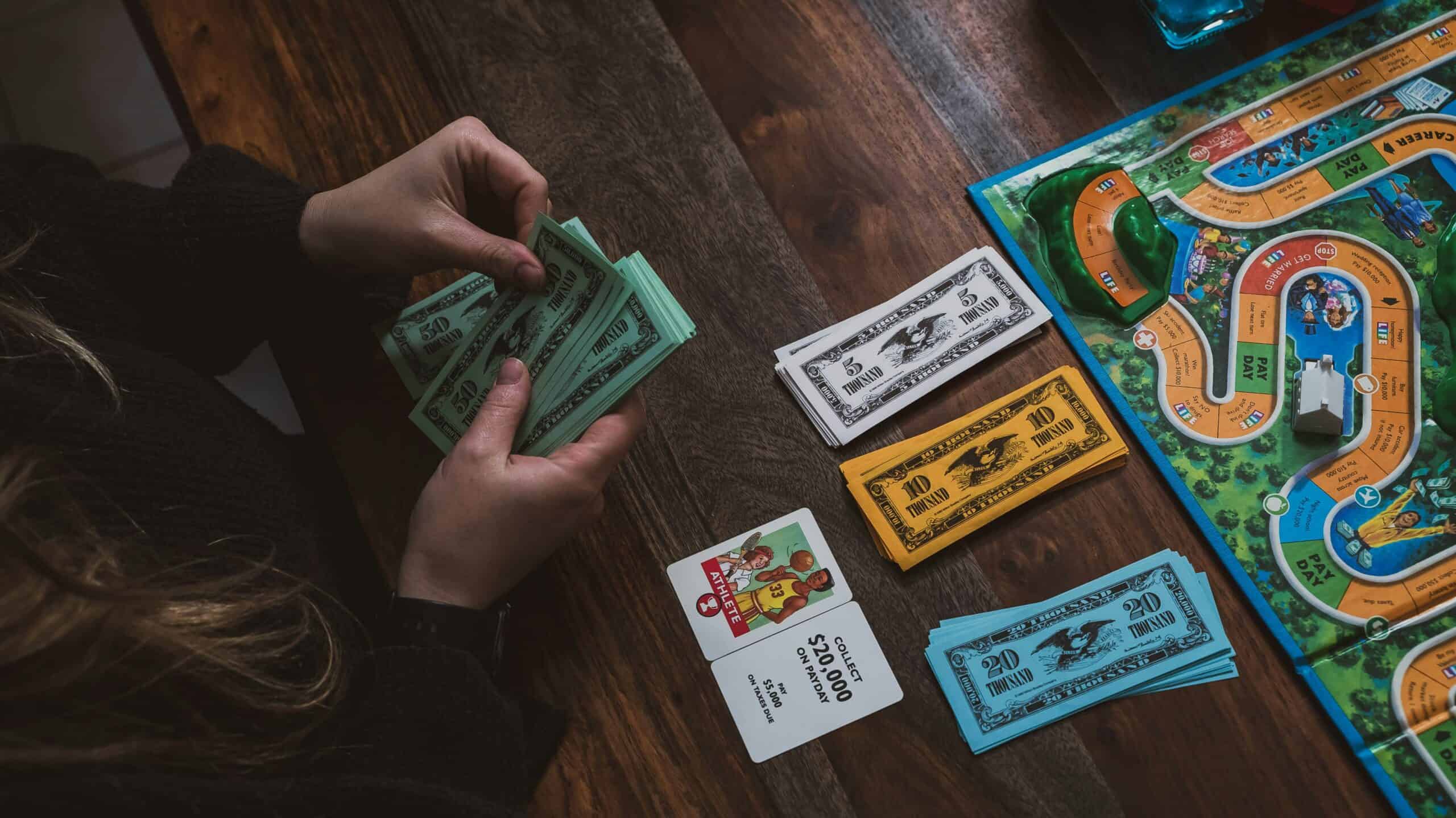With something to suit all ages and players, board games are played by people all over the world. Although new technologies initially threatened the well-loved pastime, their social nature offers a different form of entertainment which has helped them maintain their popularity. Through this article, we look at key trends within the industry, the most recognized titles and even the behaviors of those that enjoy playing them.
- The global board games market was valued at $11.88 billion as of 2022.
- In terms of revenue, the global board games market generated $8 billion for the same year.
- More than 20,000 board game publishers and 150,000 board games and related titles are known to exist.
- Chess is believed to be the most popular board game of all time, with more than 3 million sets sold annually in the US alone.
- The biggest benefit of board games for 50.60% of US adults is that they provide more opportunities to socialize with other people.
- 21.40% of US adults play board games once a month and just 1.70% play them once a year.
- Word games are selected by 47.20% of US adults as their favorite type of board game, which is more than any other type.
- In a comparison of different board games, Chess was seen by 82% of US adults as a game of skill, while Chutes and Ladders was seen by 54% as a game of luck.
- Although it can lead to disqualification in professional play, 3% of US adults say they always cheat at board games in order to win.
- Also frowned upon, 3% of US adults always quit at board games when they are in a losing position.
Board games market
The board games industry is expected to grow year-on-year with no sign of slowing down. A wide-range of available games allow people of all ages and backgrounds to find something that suits their preferences, while game replayability allows consumers to feel satisfied with their purchase.
- As of 2022, the global board games market was valued at $11.88 billion.
- Global board game revenue was valued at $8 billion.
- As of 2020, more than 20,000 board game publishers are in existence.
- Asmodee accounts for the largest board game market share globally, at 18%.
- As of 2024, over 150,000 board games and related titles are listed on the popular database and forum BoardGameGeek.
A graph is given below to show the estimate global board game market value from 2022 – 2030:
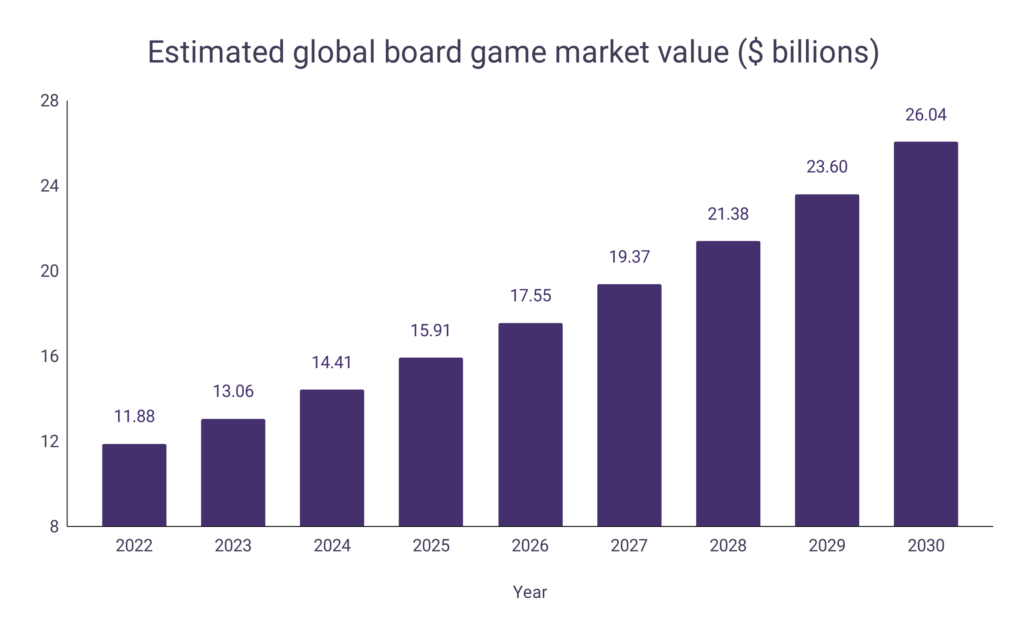
Popular board games
Both classic and modern titles feature in the list of most popular board games of all time. Due to advancements in manufacturing, clever marketing strategies and varied pricing, board games of all types are now widely-accessible, allowing consumer demand and uptake to remain high.
- Chess is estimated to be the most popular board game of all time.
- More than 3 million Chess sets are sold per year in the United States alone.
- Although lacking historic sales data, Chess is popular all over the world and is often sold with Checkers as set as it shares the same board.
- When it comes to modern board games, Monopoly and Scrabble are thought to be the most popular.
- Monopoly has sold 275 million copies and Scrabble has sold more than 150 million copies to date.
A graph is given below to compare the top board games by their relative popularity from 2019 – 2023:

Benefits of board games
The social nature of most board games encourages players to spend time together with family and friends, communicating, competing and having fun. Due to this, multiple social and mental health benefits can be gained by playing board games, especially when played with regularity.
- 50.60% of US adults feel that the biggest benefit of board games is that they allow them more opportunities to socialize.
- The development of Alzheimer’s is seen to reduce by 47% for regular board game players and puzzle solvers.
- Over a 20 year period, the risk of suffering from dementia is seen to be 15% lower for board game players when compared to those who don’t play.
- Becoming a regular board game player can increase gray matter volume in the brain, enhancing cognitive function.
- Understanding the rules of Monopoly can teach players the key principles of math (counting, addition/subtraction, multiplying and percentages).
A graph is given below to show the benefits associated with board games:
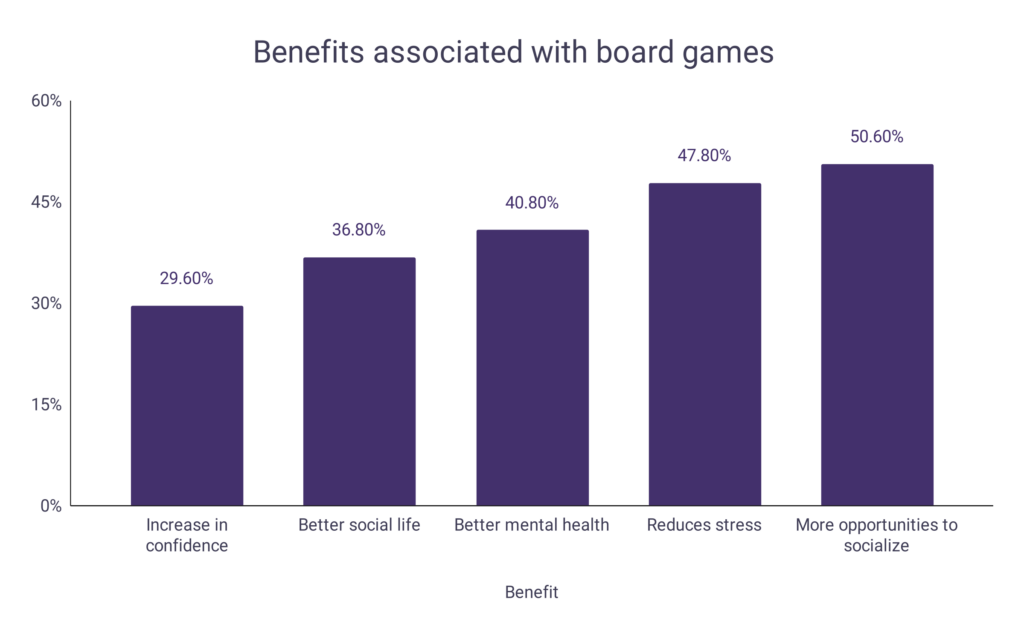
How often people play board games
One survey of US adults shows that board games are still a very common hobby for many within the population. Almost 3 out of 4 adults play board games at least once a month, while just 7.30% of people are not regular players.
| Frequency | Percentage |
| Daily | 15.50% |
| Weekly | 37.20% |
| Monthly | 21.40% |
| Once every few months | 16.50% |
| Once a year | 1.70% |
| I’ve played but not regularly | 7.30% |
| I’ve never played a board game | 0.30% |
A graph is given below to show how often people play board games:

Most popular board game types
From the most basic to the most advanced, board games can be split into many different categories. Word games are the most popular, with almost 1 in 2 players preferring to play them over all other types. However, dexterity and deduction games prove to be the least popular.
| Board game type | Percentage |
| Word games | 47.20% |
| Strategy games | 43.40% |
| Abstract games | 37.40% |
| Dice games | 31.30% |
| Trivia games | 29.30% |
| Family games | 27.50% |
| Role-playing games | 13.00% |
| Dexterity games | 9.20% |
| Deduction games | 8.50% |
A graph is given below to show the most popular board game types:
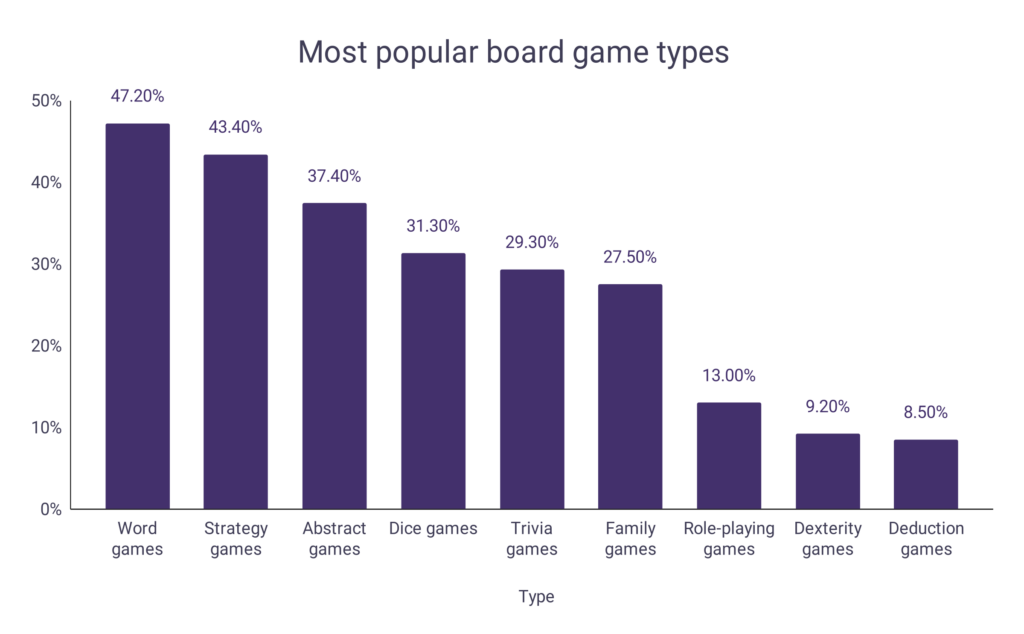
If you also love word games and are looking to improve your scores, try WordsRated’s Word Finder. Our useful tool will provide you with the best solutions, setting you well on your way to victory. Whether you would like to play a 2-letter word to remove difficult letters or play a 7-letter word to empty your rack, you can customize your search to find the perfect next move!
Opinions on board games – skill vs. luck
Often, the key to a board game being popular or not is the balance between the skill or luck needed to win. Typically, games that require a higher level of skill are more appropriate for adult players, while luck based games are usually played by younger age groups. However, games that require significantly more of one than the other still feature in the most popular list of board games.
| Board game | Opinion: Skill | Opinion: Luck | Opinion: Don’t know/other |
| Chess | 82% | 4% | 14% |
| Checkers | 77% | 10% | 13% |
| Scrabble | 76% | 9% | 14% |
| Connect 4 | 49% | 21% | 30% |
| Clue | 46% | 23% | 30% |
| Backgammon | 45% | 13% | 42% |
| Battleship | 45% | 31% | 23% |
| Monopoly | 42% | 46% | 12% |
| Yahtzee | 22% | 49% | 29% |
| The Game of Life | 16% | 46% | 38% |
| Settlers of Catan | 15% | 6% | 80% |
| Chutes and Ladders | 11% | 54% | 35% |
Cheating at board games
Although cheating in board games is not accepted, there are still a number of people that will look to take any steps necessary to get ahead. Men report cheating at board games slightly more frequently than women, although the percentage of people that admit to it is quite low, around 30%. It is important to note that as it is seen as a negative trait, many survey respondents may not feel comfortable admitting to doing it.
| Frequency | All adults | Men | Women |
| Never cheat | 68% | 65% | 71% |
| Rarely cheat | 9% | 10% | 8% |
| Sometimes cheat | 4% | 5% | 4% |
| Often cheat | 3% | 5% | 2% |
| Always cheat | 3% | 3% | 2% |
A graph is given below to show how frequently adults cheat at board games:

Quitting board games when losing
As with cheating, the decision to quit board games when losing out of disappointment or anger is seen as bad conduct. 55% of adults say they never quit and there isn’t too much of a difference in trend between men and women. Again, it should be noted that respondents to the survey may not wish to admit to ending board games in this way.
| Frequency | All adults | Men | Women |
| Never quit | 55% | 51% | 59% |
| Rarely quit | 13% | 13% | 14% |
| Sometimes quit | 10% | 13% | 7% |
| Often quit | 5% | 5% | 4% |
| Always quit | 3% | 3% | 3% |
A graph is given below to show how frequently adults quit board games when losing:
